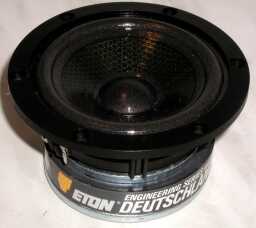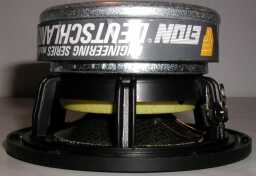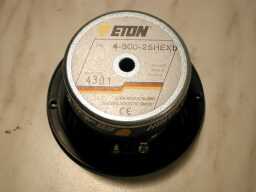 Actually I wasn't. This
little Rascal is a pure winner: Just check its CV (Measured values!!):
Actually I wasn't. This
little Rascal is a pure winner: Just check its CV (Measured values!!):Updated:
08-Dez-06
Introduction and cooking lessons....
If you like to eat a good steak, you want the meat to be cut from the finest Argentine or Scottish beef, isn't it? But the steak is not the whole meal, it must be cooked to perfection, you need the side orders to match and last but not least, the gravy..... What is this? RTL4? (Dutch joke, Sorry) No, this is Building your Own Speakers; this is EXACTLY the same. So we start with some good beef: The Loudspeaker units....
As said earlier, I was not in a certain need for building new speakers, but my interest was raised by the extreme positive press ETON (a small German Manufacturer) was getting in the DIY Audio press. This units are becoming the "secret" tip. Also my experience with the Master SUB is nothing than positive. The last drip was a "high end design" in the Klang & Ton (The leading German LS DIY magazine) with their new tweeter, the ER4. This reminded me to the incredible transparent sound, which is possible with electrostatic loudspeakers. For the rest the ESL's have nothing than disadvantages (Sorry ESL lovers, I had 4 sets, including DIY etc. superb mid/high, but for the rest, forget it !). So, could this be the final trigger I was "waiting" for? I think so. Lets kick this project of with some boring facts etc etc: (needs to be done as well)
Design Considerations
OK, what is it I want / require from the final result? let start with the low/midrange unit:
Surprised I came to the conclusion there is now way around this speaker here below ??
 Actually I wasn't. This
little Rascal is a pure winner: Just check its CV (Measured values!!):
Actually I wasn't. This
little Rascal is a pure winner: Just check its CV (Measured values!!):
| Full Name | ETON
4-300/25HEX |
| Fs | 62Hz |
| Freq. Range | 150 Hz - 5 kHz |
| SPL | 87 dB (I will use 2, --> 90dB) |
| Re | 5.4 Ohm |
| QMS | 1.13 |
| QES | 0.34 |
| QTS | 0,29 effective value |
| VAS | 5.0 liter |
| Xmax | 4 mm |
| Le | 0.29 mH |
| SD | 57 cm2 |
| Mms | 5,9 gram (!!) |

Just have a closer look to this unit. Superb manufacturing, quality materials etc. But of course the key is the HEXACONE patent from Eton. This (roughly 5mm thick) Hexagonal wafer construction is leading to a stiff cone with light mass. In stead of breaking up early (normally round 2kHz) this cone behaves like a real piston !! First break ups are at 7-8 kHz. No Problem to filter away ! Exactly what we were looking for. All other parameters are just fine to allow an easy filter design and enclosure. See the other sections for this.
And now going for the desert ....... the ER4.
This is a very special case. If you
look at the picture left, you will see a thin and very solid looking unit. Actually the
back of the unit is the permanent Magnet,  creating a homogeneous magnetic field around
the Foil, which is folded like a harmonica. On this foil, conducting tracks are the
"voicecoil". As signal is applied the harmonica will contract and distract. The
air is squeezed in two directions with MUCH higher speed. Result? extreme dynamics and
detail. What else? 1/3 rd of the mass of a standard soft dome, by ten times the cm2
......... This units can handle power and has a low Fs of 450 Hz according to the
Supplier. Well................ I measured round 600 Hz, but who cares? it is LOW for a
tweeter !!! Oh, what a luxury, the Tweeter goes till 600Hz, the LMS till 5kHz !!! I will
pick an as low as possible corner frequency, so the ER4 Air Motion Transformer will have
most of the mid/high spectrum. Both units will play at ease.
creating a homogeneous magnetic field around
the Foil, which is folded like a harmonica. On this foil, conducting tracks are the
"voicecoil". As signal is applied the harmonica will contract and distract. The
air is squeezed in two directions with MUCH higher speed. Result? extreme dynamics and
detail. What else? 1/3 rd of the mass of a standard soft dome, by ten times the cm2
......... This units can handle power and has a low Fs of 450 Hz according to the
Supplier. Well................ I measured round 600 Hz, but who cares? it is LOW for a
tweeter !!! Oh, what a luxury, the Tweeter goes till 600Hz, the LMS till 5kHz !!! I will
pick an as low as possible corner frequency, so the ER4 Air Motion Transformer will have
most of the mid/high spectrum. Both units will play at ease.

The harmonica foil of the Air Motion Transformer in detail.......... The air is pushed out explosively between the folded shape of the foil as signal is applied. The unit can be used as Dipole radiator or in a closed enclosure with damping at the back. It seems that the amount of damping has quite some influence on the frequency response. Well, we will find out by trying and MEASURING....
The conducting tracks on the foil, have, by nature, no induction (flat zig zag). This results in a very nice positive side-effect: This unit behaves as a PURE RESISTOR !!! Just a very little up peak at Fr, but the curve is flat as the Dutch Polders....... (see Filter section for more details). Easier Filtering is not possible.... Just one remark here: Eton claims in its datasheets the "Impedance" is 8 Ohm. So, you want a fo of 3kHz and a first order filter? therefore the series C will be, uhh yes exactly 6.8uF. Purchase the right Capacitor, put it in the filter and all set, or..................? Well BULLSHIT !!! , Sorry for my French, but I like to come back to my earlier prayers of MEASURING. I checked the impedance curve and actually, the impedance is 3.5 - 3.7 Ohm, not really close to 8, eh? ETON, you produce great units, can't you produce proper datasheets as well? Just imagine, with 6.8 uF your fo will be 6,5 kHz. And you wonder later on, why your speaker system sounds so thin, so body less ?? OK, enough of this. I made my case clear and in the filter section we will have all the details, but still, grrrrr
Just to finish this
section:
The ER-4 Air Motion Transformer (Measured) DATA:
Full Name |
Eton ER-4 |
Impedance (=Re) |
3.6 Ohm average |
Fs |
~ 600 Hz |
Freq. Range |
1,5 kHz - >20kHz |
SPL |
92 dB |
Moving Mass |
100 mg ( !! ) |
Membrane Area |
67 cm2 (more than the LMS !) |
I hope you will agree, that these are real fine ingredients for a nice audio meal...... Now we only need the right recipe to use these ingredients properly, so read the other segments and enjoy !
Happy Listening and Building !!!!
Doede Douma
IMPORTANT: The information provided on this page is intended as guide for DIY activities and therefore free to copy and or publish. If any one wishes to use any of the information from my WEB site, please make sure to refer and footnote to my URL Link as source! Doede Douma